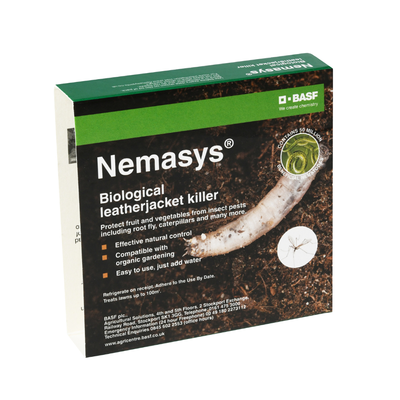Protect lawns from leatherjackets this autumn with an organically compatible solution
Published:
Read Time: 2 mins
As we head out of summer and into autumn, adult crane flies will emerge from their pupae and begin to lay eggs in the moist soil and turf around the garden, creating two issues for lawns and gardeners. The larvae, known as leatherjackets, make delicious snacks for magpies, crows, badgers, and foxes which will scrape, burrow, and dig in search of their supper, whilst destroying the lawn in the process. If this doesn’t decimate the lawn, then the grubs themselves will. Leatherjackets attack grass roots resulting in slow growth and yellow patches, leaving it easy to pull up, with little or no roots.
To stop this damaging activity, treat lawns with Nemasys Biological Leatherjacket Killer, which targets the leatherjackets by releasing millions of microscopic nematodes that will penetrate the soil, seek out the pests and kill them. This organically compatible treatment can be used on lawns where pets and children play, and users needn’t worry about runoff into organic fruit and veg patches.
Nematodes occur naturally in soil and BASF breeds specific types that each seek out and kill particular prey.
Leatherjackets are about 25mm long, brown, legless and with no distinct head. They are the larval stage of daddy long legs, which can first be spotted in springtime, and lay eggs within days. These hatch within two weeks and start to feed on grass roots. A good rule of thumb is to wait two weeks from when you first see daddy long legs, and apply nematodes, and then apply again in two weeks’ time, keeping the soil moist throughout.
Nemasys Leatherjacket Killer is easily applied. It arrives in the form of a fibrous paste, which you then disperse in water (following mixing guidelines). The mixture can then be applied via a watering can with a coarse rose for a small lawn or with a hose-end feeder for larger lawns.
Once the leatherjacket population has been reduced by the nematodes, the large number of nematodes applied will die back to their original numbers found naturally in the soil as there will be no prey to feed on.
An entire season’s worth of pest control can be purchased now via online stockists, to be delivered fresh, straight to your door.
To find out more about how nematodes work, take a look at this short video - https://youtu.be/JHNG1KSluh0
For further information please visit https://www.nemasysinfo.co.uk/ and follow basf_nemasys_uk on Instagram.
Ends
Editors notes
Nematodes are naturally occurring microscopic worms, already present in our soil. Beneficial nematodes attack and kill targeted garden pests. They are compatible with organic farming, easy to use and can even be kept in your fridge!
Research scientists have isolated the nematodes that kill specific garden pests including Slugs, Vine weevils, Leatherjackets, Caterpillars, Codling moth and much more.
BASF’s state of the art production facility in the UK produces billions of nematodes in a form that is easily applied by gardeners. Over 20,000 different species of nematodes have been classified, although some estimates put the total figure closer to one million! BASF has the largest specialist nematode production facility in the world, growing trillions of beneficial nematodes for use in their Nemasys range of pest control products.
BASF experts are available for interviews, features and expert comment on biological pest control management, and product is available for reviews, competitions and product trials.



